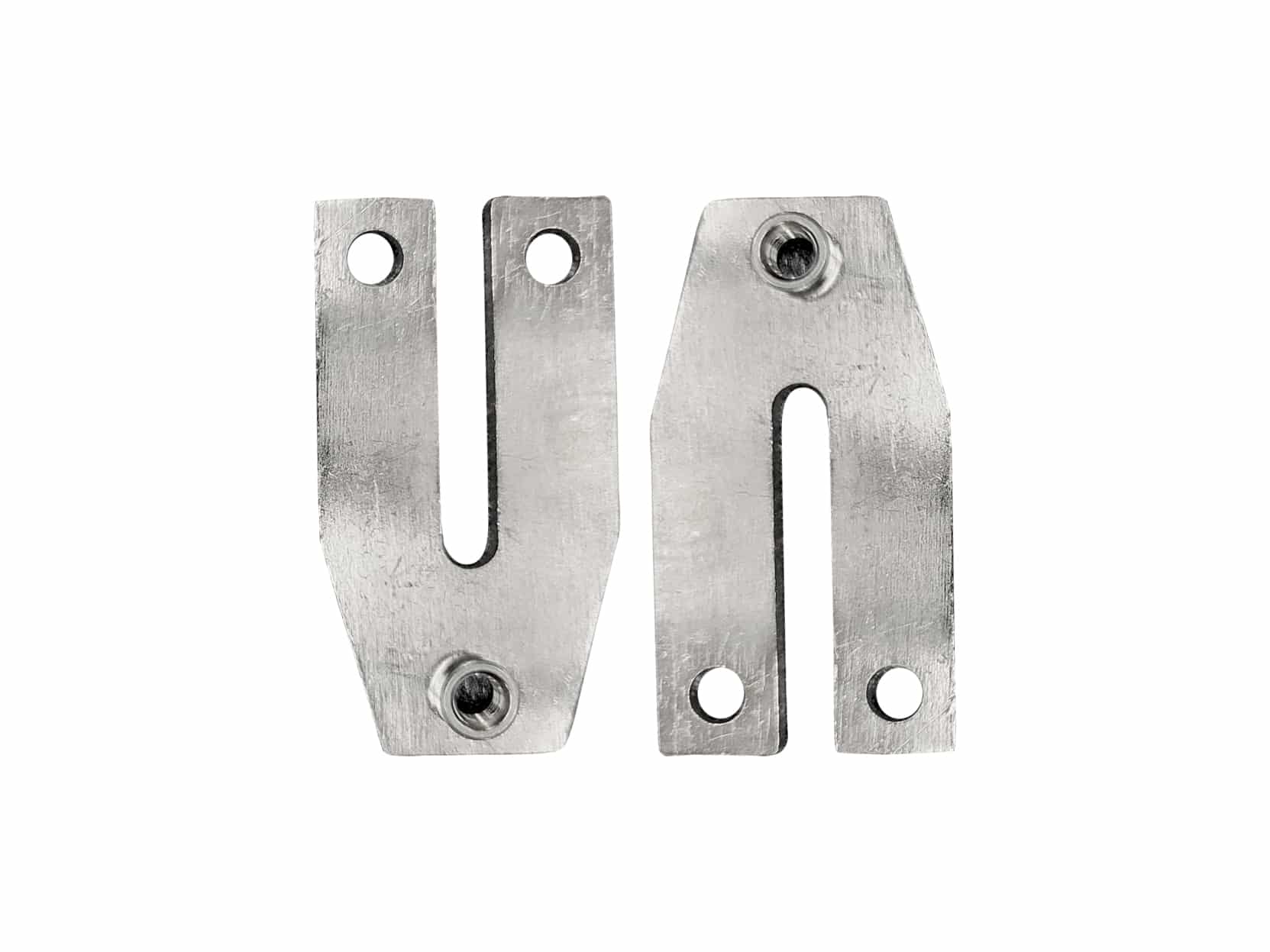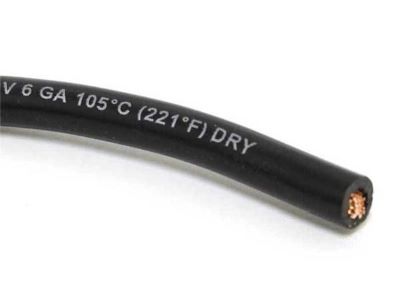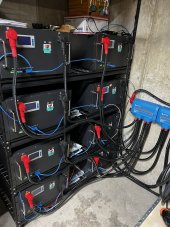What size battery cable for 300A? All the charts I find for battery cable sizing only go to 230 or so. I find welding cable charts but that is for intermittent use. What would the appropriate wire gauge be for a 300 amp continuous rating with a roundtrip of 10ft. (Probably be less but playing it safe).
You are using an out of date browser. It may not display this or other websites correctly.
You should upgrade or use an alternative browser.
You should upgrade or use an alternative browser.
Battery Cable size
- Thread starter Jet
- Start date
6
629658
Guest
4/0 is the largest you will be able to work with. Anything larger you will run into issues with lugs and terminations. I would suggest running a buss system using all 4/0 premium wire like Ancor brand marine cable. Not cheap but high quality. Don’t skimp on the lugs either Ancor brand also. I’d run double between the buss and the inverter.
This might help:

 practicalpreppers.com
practicalpreppers.com
Use a good quality buss system like the Victron Power In’s.
This might help:

Busbar Pair for Sol-Ark 15k Inverters - Practical Preppers
Busbar pair for Sol-Ark 15k inverters! Made by HomeGrid. FREE SHIPPING!
Use a good quality buss system like the Victron Power In’s.
Attachments
EastTexCowboy
Solar Wizard
I used 4/0 welding cable from Windy Nation. 10 ft runs on six EG4 LifePower4 48v. Have another set of same batteries that still have 2/0 welding cable from the same vendor and both sets are room temp even after max load for several hours. I've thought about upgrading the 2/0 to 4/0 and I may do so, but it's working fine as it is.What size battery cable for 300A? All the charts I find for battery cable sizing only go to 230 or so. I find welding cable charts but that is for intermittent use. What would the appropriate wire gauge be for a 300 amp continuous rating with a roundtrip of 10ft. (Probably be less but playing it safe).
6
629658
Guest
I chose the Ancor marine 4/0 for several reasons. 1 it’s UL listed, 2 it’s micro strand and 3 it’s tinned copper. Corrosion resistant and when combined with Ancors tinned copper UL lugs, hydraulic crimper and adhesive shrink wrap you get a near waterproof cable so zero corrosion over many years. So one less thing to cause problems. Especially if you live in a humid climate.I used 4/0 welding cable from Windy Nation. 10 ft runs on six EG4 LifePower4 48v. Have another set of same batteries that still have 2/0 welding cable from the same vendor and both sets are room temp even after max load for several hours. I've thought about upgrading the 2/0 to 4/0 and I may do so, but it's working fine as it is.
EastTexCowboy
Solar Wizard
I don't disagree at all. Mine is in the garage which will soon be climate controlled. I used manual crimper and regular shrink wrap but I think it will probably hold up well in that environment.I chose the Ancor marine 4/0 for several reasons. 1 it’s UL listed, 2 it’s micro strand and 3 it’s tinned copper. Corrosion resistant and when combined with Ancors tinned copper UL lugs, hydraulic crimper and adhesive shrink wrap you get a near waterproof cable so zero corrosion over many years. So one less thing to cause problems. Especially if you live in a humid climate.
DIYrich
Solar Wizard
Some places say you can use smaller wire for short lengths of DC. 2/0 wire 300 amps up to 11 ft.

Any thoughts?

Battery Cable - Gauges from 6 through 4/0 - WiringProducts, Ltd.
Gauges 6 through 2/0 are made from 133 strands and 3/0 - 4/0 gauges are made with 361 strands of true 21 gauge copper conductor wire covered in a durable, high temperature resistant thermoplastic polyvinyl chloride (PVC) insulation. Excellent conductivity maximizes current flow while still being...
wiringproducts.com
Any thoughts?
EastTexCowboy
Solar Wizard
I've found a lot of discrepancy between various wire size calculators and charts, as well as different vendors. I suspect there's a bit of safety cushion built in for most of them. I have the 2/0 on a 10' run with 6 of the 5.1kWh EG4 batteries and it's been that way for a few months. I've checked the temps with a laser heat gun as well as with a thermal camera and have seen not even a slight temp rise. That said, when I added the second rack with a 12' run I went ahead and got the 4/0. Someday I may get bored and swap out the 2/0 but I wouldn't leave it if I thought there was a risk. I do have a 300a Class T fuse on both runs as well as a 200a breaker on each. The breaker should trip before it fries any of the cables.Some places say you can use smaller wire for short lengths of DC. 2/0 wire 300 amps up to 11 ft.

Battery Cable - Gauges from 6 through 4/0 - WiringProducts, Ltd.
Gauges 6 through 2/0 are made from 133 strands and 3/0 - 4/0 gauges are made with 361 strands of true 21 gauge copper conductor wire covered in a durable, high temperature resistant thermoplastic polyvinyl chloride (PVC) insulation. Excellent conductivity maximizes current flow while still being...wiringproducts.com
Any thoughts?
This interactive wiring calculator has been recommended here many times: https://baymarinesupply.com/calculator
It shows 2/0 as being sufficient, but heavier gauge wire will reduce the voltage drop a bit.
It shows 2/0 as being sufficient, but heavier gauge wire will reduce the voltage drop a bit.
6
629658
Guest
I’m oversized but everything is cool running and little voltage drop. Performing extremely well.
Thanks for that link. I figured this all out a year ago and forgot where I got the information. The plan then was to use 2/0 for the battery cable but that was just with one 3kw inverter and some DC loads. I decided to change the system with two inverters. Is that wire calculator for continuous load or just intermittent? The other charts I was looking at are for building water I think and are assuming you're using long lengths. By those charts I would need 300KCMIL wire. I think I'll go with 4/0 250 mcm isn't much more but it's probably overkill and I have some 4/0 lugs and that is the largest size my hydraulic crimper can do.This interactive wiring calculator has been recommended here many times: https://baymarinesupply.com/calculator
It shows 2/0 as being sufficient, but heavier gauge wire will reduce the voltage drop a bit.
Is that wire calculator for continuous load or just intermittent?
That's a good question. I would assume continuous but a quick email to Bay Marine Supply would get you the answer. They're pretty good at responding to email.
SniperX
Solar Enthusiast
- Joined
- Apr 1, 2021
- Messages
- 347
Late to the game, but would you use windy nation welding cable for the EG4 batteries (10' 4/0) or would you go with Ancor or even Arctic Ultraflex blue wiring? I have the windy nation when Will was recommending but I wonder...I have 6 EG4 V1 batteries and a single Schneider XW Pro. The Schneider uses the Arctic Blue wiring in their larger PDP (wire that comes with their PDP) and that is why I am wondering if I should just use the same brand? Cost is not an issue so much as safety is the issue.That's a good question. I would assume continuous but a quick email to Bay Marine Supply would get you the answer. They're pretty good at responding to email.
Do you have any issues with current windy nation cabling you have?Late to the game, but would you use windy nation welding cable for the EG4 batteries (10' 4/0) or would you go with Ancor or even Arctic Ultraflex blue wiring? I have the windy nation when Will was recommending but I wonder...I have 6 EG4 V1 batteries and a single Schneider XW Pro. The Schneider uses the Arctic Blue wiring in their larger PDP (wire that comes with their PDP) and that is why I am wondering if I should just use the same brand? Cost is not an issue so much as safety is the issue.
So far that’s the only cabling I’ve bought, 4awg and 2/0.
Only downside I’d have to say about it is the jacket is kinda a tacky rubber (edpm?) animal hair loves to stick to it. It’s very mailable if you stick to the “memory” of the coil, but also prob not the most abrasive resistant. I have some carol ultraflex 12-3 SJOOW from mid 2000’s that I love and was kind of expecting, but then that’s for more portable stuff.
It’s not really a negative just more an observation. I had the 4awg for my 1500w 12v system and bought their 2/0 for my MPII 3k upgrade.
If you keep to the “memory” of the cabling when you crimp it is great cables, but I am sure it is on the economy side and better options if willing to drop the cash. For me it’s good enough and at a nice price point.
Late to the game, but would you use windy nation welding cable for the EG4 batteries (10' 4/0) or would you go with Ancor or even Arctic Ultraflex blue wiring? I have the windy nation when Will was recommending but I wonder...I have 6 EG4 V1 batteries and a single Schneider XW Pro. The Schneider uses the Arctic Blue wiring in their larger PDP (wire that comes with their PDP) and that is why I am wondering if I should just use the same brand? Cost is not an issue so much as safety is the issue.
I have not shopped for retail cable that comes with lugs. My only concern with buying cables from someone else is that you have to order the length longer than you expect because it's hard to account for bends. Order too short and the cable is useless. Order too long and you have to figure out a way to deal with the excess. I made my own cables and they came out exactly the length I needed with the lugs oriented just the right way.
I purchased Windy Nation inline PV fuses. I didn't use them since my panels are wired in series, but the fuses looked good.
RCinFLA
Solar Wizard
- Joined
- Jun 21, 2020
- Messages
- 3,565
10 foot cable length pair (pos and neg) 20' total path length.
fine strand copper welding cable
300 amps continuous current.
00 = 1.68 milliohms = 0.505v total voltage drop @ 300A, 151 watts of cable loss heating
000 = 1.34 milliohms = 0.401v total voltage drop @ 300A, 120 watts of cable loss heating
0000 = 1.05 milliohms = 0.301v total voltage drop @ 300A, 95 watts of cable loss heating
What is acceptable depends on inverter DC input voltage. 12v 3000 watt inverter is marginally okay with 0000. You cannot afford much voltage drop with 12v inverters. You are also going to have connector lugs, fuse, and any current shunt measurement resistance.
fine strand copper welding cable
300 amps continuous current.
00 = 1.68 milliohms = 0.505v total voltage drop @ 300A, 151 watts of cable loss heating
000 = 1.34 milliohms = 0.401v total voltage drop @ 300A, 120 watts of cable loss heating
0000 = 1.05 milliohms = 0.301v total voltage drop @ 300A, 95 watts of cable loss heating
What is acceptable depends on inverter DC input voltage. 12v 3000 watt inverter is marginally okay with 0000. You cannot afford much voltage drop with 12v inverters. You are also going to have connector lugs, fuse, and any current shunt measurement resistance.
S Davis
Solar Enthusiast
- Joined
- Sep 25, 2021
- Messages
- 601
Once I found DLO cable that is the only thing I use, it is pricy but very tough jacket and a great bend radius.

 www.wireandcableyourway.com
www.wireandcableyourway.com

4/0 Diesel Locomotive Cable 2KV
Diesel Locomotive Cable. Cut to length - sold by the Foot.
S Davis
Solar Enthusiast
- Joined
- Sep 25, 2021
- Messages
- 601
8XODWhat’s the bend radius on that stuff?
SniperX
Solar Enthusiast
- Joined
- Apr 1, 2021
- Messages
- 347
I would order length and then make my own cables. If I order too much, I have other places I could use it. I just wanted to know if anyone thought the welding cable would hold up to the 6 EG4s going to the Schneider. It says it has a jacket rating ofI have not shopped for retail cable that comes with lugs. My only concern with buying cables from someone else is that you have to order the length longer than you expect because it's hard to account for bends. Order too short and the cable is useless. Order too long and you have to figure out a way to deal with the excess. I made my own cables and they came out exactly the length I needed with the lugs oriented just the right way.
I purchased Windy Nation inline PV fuses. I didn't use them since my panels are wired in series, but the fuses looked good.
I saw that! Thought it was pretty cool. Dave Poz bought his 2AWG cabling to the PDP from his charge controller on that site you referenced.Once I found DLO cable that is the only thing I use, it is pricy but very tough jacket and a great bend radius.

4/0 Diesel Locomotive Cable 2KV
Diesel Locomotive Cable. Cut to length - sold by the Foot.www.wireandcableyourway.com
Similar threads
- Replies
- 6
- Views
- 179
- Replies
- 11
- Views
- 480



